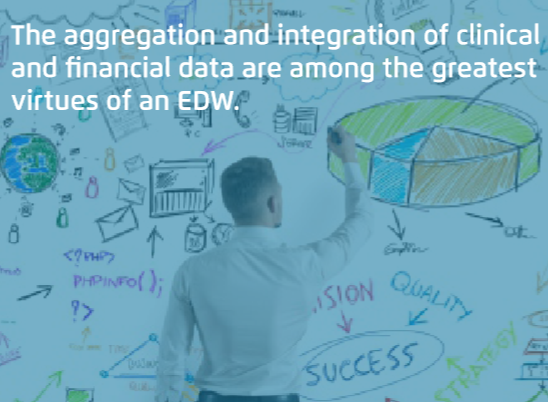 Gartner, HIMSS separately report rising interest in healthcare data warehousing
Gartner, HIMSS separately report rising interest in healthcare data warehousing
Mounting evidence indicates the 57 percent of US hospitals with at least a basic electronic health record (EHR) have shifted their IT priorities toward systems like the enterprise data warehouse (EDW) that mine the EHR for insights to improve care and lower costs.
According to a recent report from Gartner, “integrating business/financial and clinical data into an effective EDW is the top new IT initiative for HDO (healthcare delivery organization) CIOs once a Generation 3 EHR system is deployed.” Independently, a February survey by the Healthcare Information & Management Systems Society (HIMSS) revealed that, as more hospitals achieve Stage 1 Meaningful Use of an EHR, their technology leaders are making the EDW a top IT priority.
In this environment, hospitals and health systems need more information to help determine what type of data warehouse best satisfies the growing demand for analytics and performance improvement.
To help provide the answers, Health Catalyst has released a new eBook, It All Starts With a Data Warehouse, authored by some of the nation’s top EDW experts. The free eBook explores common approaches to data warehousing in healthcare, key success factors, mistakes to avoid, and real-world examples of healthcare organizations that have used their data warehouse to improve operational efficiency and quality of care while increasing ROI.
“If you’re going to achieve high performance analytics, the EHR alone won’t cut it,” writes co-author Dale Sanders, senior vice president of strategy for Health Catalyst, and an early pioneer in healthcare data warehousing. “You need an enterprise data warehouse. In fact, there is no viable technical alternative to an enterprise data warehouse if you want to successfully use analytics to improve the longitudinal cost and quality of care.”
Gartner Report Reviews 25 Years of EDW Mistakes
Health Catalyst’s leadership in healthcare data warehousing and analytics has been acknowledged by numerous research firms including KLAS and Chilmark. Gartner named Health Catalyst a “Cool Vendor for Healthcare Providers,” in 2013. In that report, Gartner Research Vice President and Global Industry Services Director for Healthcare Providers Vi Shaffer wrote that “treating information as a strategic asset and investing in a well-used EDW that is tightly linked to change management strategies are critical actions for HDOs in the era of accountability.”
That observation is the starting point for the most recent Gartner report, “Top Actions for Healthcare Delivery Organization CIOs, 2014: Avoid 25 Years of Mistakes in Enterprise Data Warehousing,“ co-authored by Shaffer and fellow Gartner analyst Mark Bayer. The report reviews a quarter century of mistakes in data warehousing and sets forth recommendations for successful EDW implementations. Shaffer and Bayer contend that the EDW is critical to the “superior use of analytics (which) will be a dominant factor in health system success for the rest of this decade, and it is a growing component of the CIO work.”
HIMSS data reveals uptick in EDW interest among IT leaders
Healthcare CIOs apparently already agree with Gartner. According to the 25th Annual HIMSS Leadership Survey, released in February, the number of hospitals that say their top IT priority is leveraging information through data warehouses and business intelligence systems has nearly doubled since 2011 (from 9 percent to 17 percent). The category ranks No. 3 overall on the list of IT priorities for 2014.
During the same time period, the number of HIMSS survey respondents who ranked Meaningful Use as their top IT priority fell from 49 percent to 25 percent. That rapid downturn reinforces the shift in investment away from the EHR and toward other technologies that can analyze the EHR’s clinical data for insights to improve care.
The HIMSS survey identified two related trends that support this thesis:
- Success with meaningful use equals greater focus on meaningful analytics: More than 90 percent of hospital leaders in the study have already qualified for Stage 1 Meaningful Use and approximately three-quarters indicated they expect to qualify for Stage 2 in 2014. As a result, hospitals should be less focused on meeting regulatory requirements and more able to devote resources to solutions that help improve care and reduce costs.
- Increasing focus on operational efficiencies and quality of care: While respondents continued to identify their single biggest business objective as “sustaining financial viability,” the next two top objectives were “improving operational efficiencies” (16 percent) and “improving patient care/quality of care” (14 percent). Both are key capabilities of Health Catalyst’s Late-Binding™ EDW and analytics platform.
“The HIMSS data reflects a clear trend in the market that we have long predicted,” said Steve Barlow, senior vice president and co-founder of Health Catalyst, previously a senior data warehouse executive at Intermountain Healthcare. “As more healthcare organizations successfully deploy EHRs and strive for accountable care, they are looking for ways to take full advantage of all of that rich clinical data by deploying an EDW as their analytics foundation of the future. That’s why we felt this eBook was needed to help healthcare leaders clearly assess the best approach to an EDW for their organization.”
The free Health Catalyst eBook can be downloaded here.
